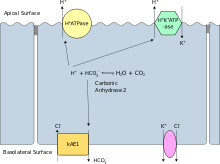Distal renal tubular acidosis
| Distal renal tubular acidosis | |
|---|---|
| Other names: Type 1 renal tubular acidosis | |
 | |
| Radiograph of a rickets sufferer, a complication of both distal and proximal RTA. | |
Distal renal tubular acidosis (dRTA) is the classical form of RTA, being the first described. Distal RTA is characterized by a failure of acid secretion by the alpha intercalated cells of the distal tubule and cortical collecting duct of the distal nephron.[1] This failure of acid secretion may be due to a number of causes. It leads to relatively alkaline urine, due to the kidney's inability to acidify the urine to a pH of less than 5.3.[citation needed]
Symptoms and signs

Because renal excretion is the primary means of eliminating acid from the body, there is consequently a tendency towards acidemia. This leads to the clinical features of dRTA:[2][3]
- Normal anion gap metabolic acidosis/acidemia
- Hypokalemia
- Urinary stone formation (related to alkaline urine, hypercalciuria, and low urinary citrate).[4]
- Nephrocalcinosis (deposition of calcium in the substance of the kidney)
- Bone demineralisation (causing rickets in children and osteomalacia in adults)
- Impaired growth (children)
The symptoms and sequelae of dRTA are variable and range from being completely asymptomatic, to loin pain and hematuria from kidney stones, to failure to thrive and severe rickets in childhood forms as well as possible renal failure and even death
dRTA commonly leads to sodium loss and volume contraction, which causes a compensatory increase in blood levels of aldosterone.[5] Aldosterone causes increased resorption of sodium and loss of potassium in the collecting duct of the kidney, so these increased aldosterone levels cause the hypokalemia which is a common symptom of dRTA.[5]
Causes

- Autoimmune disease. Classically Sjögren's syndrome, but it is also associated with systemic lupus erythematosus, rheumatoid arthritis and even hypergammaglobulinemia. Hypokalaemia is often severe in these cases.[6]
- Hereditary causes include mutations of Band 3[7] the basolateral bicarbonate transporter of the intercalated cell, which may be transmitted in an autosomal dominant fashion in western European cases, or in an autosomal recessive fashion in South East Asian cases. The South East Asian cases are associated with more severe hypokalemia.[8] Other hereditary causes include mutations of subunits of the apical proton pump vH+-ATPase,[9] which are transmitted in an autosomal recessive fashion, and may be associated with sensorineural deafness.[10]
- Liver cirrhosis.
- Nephrocalcinosis. While it is a consequence of dRTA, it can also be a cause; related to calcium-induced damage of the cortical collecting duct.
- Renal transplantation.
- Sickle cell anemia.
- Toxins, including ifosfamide (more commonly causing pRTA than dRTA),[11] lithium carbonate[12] and amphotericin B.[13]
- Chronic urinary tract obstruction.
- Toluene causes a non-anion gap metabolic acidosis with hypokalemia and a positive urinary anion gap that looks a lot like distal RTA but there is no hydrogen secretion defect and the acidosis is due to acid production during the metabolism of toluene.[14]
Diagnosis
The pH of patient's blood is highly variable, and acidemia is not necessarily characteristic of sufferers of dRTA at any given time. One may have dRTA caused by alpha intercalated cell failure without necessarily being acidemic; termed incomplete dRTA, which is characterized by an inability to acidify urine, without affecting blood pH or plasma bicarbonate levels.[15] The diagnosis of dRTA can be made by the observation of a relatively alkaline urinary pH of greater than 5.3 in the face of a systemic acidemia (usually taken to be a serum bicarbonate of 20 mmol/L or less). In the case of an incomplete dRTA, failure to acidify the urine following an oral acid loading challenge is often used as a test. The test usually performed is the short ammonium chloride test,[16] in which ammonium chloride capsules are used as the acid load. More recently, an alternative test using furosemide and fludrocortisone has been described.[17]
dRTA has been proposed as a possible diagnosis for the unknown malady plaguing Tiny Tim in Charles Dickens' A Christmas Carol.[18][19]
Treatment
This is relatively straightforward. It involves correction of the acidemia with oral sodium bicarbonate, sodium citrate or potassium citrate. This will correct the acidemia and reverse bone demineralisation. Hypokalemia and urinary stone formation and nephrocalcinosis can be treated with potassium citrate tablets which not only replace potassium but also inhibit calcium excretion and thus do not exacerbate stone disease as sodium bicarbonate or citrate may do.[20]
See also
References
- ↑ "Osmosis: Renal tubular acidosis". Osmosis. Archived from the original on 2020-10-20.
- ↑ Laing CM, Toye AM, Capasso G, Unwin RJ (2005). "Renal tubular acidosis: developments in our understanding of the molecular basis". Int. J. Biochem. Cell Biol. 37 (6): 1151–61. doi:10.1016/j.biocel.2005.01.002. PMID 15778079.
- ↑ "Distal renal tubular acidosis: MedlinePlus Medical Encyclopedia". medlineplus.gov. Archived from the original on 16 March 2022. Retrieved 20 May 2022.
- ↑ Buckalew VM Jr (1989). "Nephrolithiasis in renal tubular acidosis". The Journal of Urology. 141 (3 (part 2)): 731–737. doi:10.1016/S0022-5347(17)40997-9. PMID 2645431.
- ↑ 5.0 5.1 Wein, Alan, J (2011). Campbell-walsh Urology Expert Consult (PDF) (10th ed.). Philadelphia, PA: W B Saunders Co. p. 1045. ISBN 978-1-4160-6911-9. Archived (PDF) from the original on 2016-03-03. Retrieved 2022-04-18.
- ↑ Wrong OM, Feest TG, MacIver AG (1993). "Immune-related potassium-losing interstitial nephritis: a comparison with distal renal tubular acidosis". Q. J. Med. 86 (8): 513–34. doi:10.1093/qjmed/86.8.513. PMID 8210309. Archived from the original on 2008-12-12. Retrieved 2022-04-18.
- ↑ Bruce LJ, Cope DL, Jones GK, et al. (1997). "Familial distal renal tubular acidosis is associated with mutations in the red cell anion exchanger (Band 3, AE1) gene". J. Clin. Invest. 100 (7): 1693–707. doi:10.1172/JCI119694. PMC 508352. PMID 9312167.
- ↑ Bruce LJ, Wrong O, Toye AM, et al. (2000). "Band 3 mutations, renal tubular acidosis and South-East Asian ovalocytosis in Malaysia and Papua New Guinea: loss of up to 95% band 3 transport in red cells". Biochem. J. 350 Pt 1 (Pt 1): 41–51. doi:10.1042/0264-6021:3500041. PMC 1221222. PMID 10926824.
- ↑ Wagner, CA; Finberg, KE; Breton, S; Marshansky, V; Brown, D; Geibel, JP (October 2004). "Renal Vacuolar H+-ATPase". Physiological Reviews. 84 (4): 1263–314. doi:10.1152/physrev.00045.2003. PMID 15383652.
- ↑ Karet FE, Finberg KE, Nelson RD, et al. (1999). "Mutations in the gene encoding B1 subunit of H+-ATPase cause renal tubular acidosis with sensorineural deafness". Nat. Genet. 21 (1): 84–90. doi:10.1038/5022. PMID 9916796. S2CID 34262548.
- ↑ Skinner R, Pearson AD, English MW, et al. (1996). "Risk factors for ifosfamide nephrotoxicity in children". Lancet. 348 (9027): 578–80. doi:10.1016/S0140-6736(96)03480-0. PMID 8774570. S2CID 12624019.
- ↑ Boton R, Gaviria M, Batlle DC (1987). "Prevalence, pathogenesis, and treatment of renal dysfunction associated with chronic lithium therapy". Am. J. Kidney Dis. 10 (5): 329–45. doi:10.1016/s0272-6386(87)80098-7. PMID 3314489.
- ↑ McCurdy DK, Frederic M, Elkinton JR (1968). "Renal tubular acidosis due to amphotericin B". N. Engl. J. Med. 278 (3): 124–30. doi:10.1056/NEJM196801182780302. PMID 5634966.
- ↑ Carlisle, E. J.; Donnelly, S. M.; Vasuvattakul, S.; Kamel, K. S.; Tobe, S.; Halperin, M. L. (February 1991). "Glue-sniffing and distal renal tubular acidosis: sticking to the facts". Journal of the American Society of Nephrology. 1 (8): 1019–1027. doi:10.1681/ASN.V181019. ISSN 1046-6673. PMID 1912400.
- ↑ Batlle, D.; Haque, S. K. (2012). "Genetic causes and mechanisms of distal renal tubular acidosis". Nephrology Dialysis Transplantation. 27 (10): 3691–3704. doi:10.1093/ndt/gfs442. PMID 23114896.
- ↑ Wrong, O; Davies HEF (1959). "The Excretion of Acid in Renal Disease". QJM. 28 (110): 259–313. PMID 13658353.
- ↑ Walsh SB, Shirley DG, Wrong OM, Unwin RJ (2007). "Urinary acidification assessed by simultaneous furosemide and fludrocortisone treatment: an alternative to ammonium chloride". Kidney Int. 71 (12): 1310–6. doi:10.1038/sj.ki.5002220. PMID 17410104.
- ↑ Lewis D (1992). "What was wrong with Tiny Tim?". Am J Dis Child. 146 (12): 1403–7. doi:10.1001/archpedi.1992.02160240013002. PMID 1340779.
- ↑ "What Ailed Tiny Tim". Time. 1992-12-28. Archived from the original on September 30, 2007. Retrieved 2010-05-22.
- ↑ Morris RC, Sebastian A (2002). "Alkali therapy in renal tubular acidosis: who needs it?" (PDF). J. Am. Soc. Nephrol. 13 (8): 2186–8. doi:10.1097/01.ASN.0000027973.07189.00. PMID 12138154. Archived (PDF) from the original on 2009-09-26. Retrieved 2022-04-18.
External links
| Classification | |
|---|---|
| External resources |